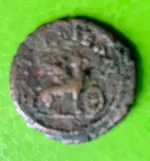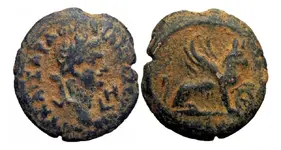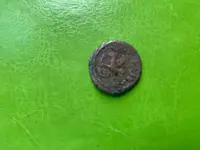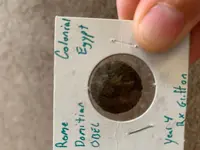This may help.
Just for clarity, there was more than one ‘Domitian’ and the Emperor referred to here was Titus Flavius Domitianus, born AD 51 and Emperor from AD 81 until his death in AD 96.
As said in the information on the ticket, the coin is from the Egyptian part of the Roman Empire (Egypt had been a Roman province since 30 BC) and would likely have been minted locally at Alexandria. Roman coins of course didn’t carry dates as such, but in some cases they do have a ‘reign year’ which enables them to be precisely dated. For Domitian’s coins minted at Alexandria, they carry letters that relate to this. I can’t read them from your pictures but, if the information with your coin correctly identifies it as ‘Year 4’ then it will have been minted in AD 84/5.
The information you have says it’s an ‘obel’, which is a mis-spelling of ‘obol’ by whoever wrote the ticket. Roman provincial coins were often aligned to prevailing local currencies, so in this case the coin is presumed to align to the obol of the Greek-speaking part of the Empire. There were six obols to the drachma. One obol would get you six pints of wine and three obols was the standard going rate for a prostitute.
Your information also says the reverse has a ‘griffon’ (more usually spelled ‘griffin’). It’s a matter of debate what you call it, since the imagery of griffins and sphinxes has similar derivations and some sources describe it as a ‘sphinx’. The latter has a more long-standing association with Egypt and is depicted both with and without wings on Domitian’s coins and elsewhere. The Romans were pretty tolerant of foreign religions and their iconography as long as they didn’t interfere with public order; so the worship of Egyptian deities flourished in Domitian’s time and Egyptian imagery on coins was seen as an appeasement to a population under the rule of Rome.
The reverse of your coin (shown here in the correct orientation and with a bit of enhancement) is similar to the one I have shown alongside. There were many variations, but it’s a griffin/sphinx with one foreleg resting on a wheel. This one I’m showing is from reign year six of Domitian’s rule and so was minted in AD 86/7.











